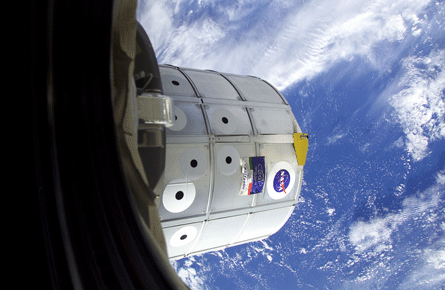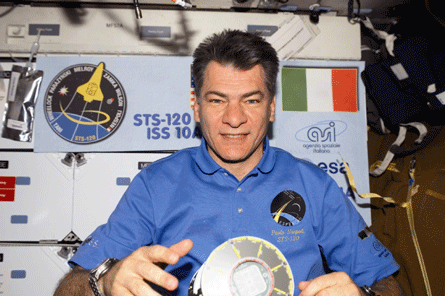The European Space Agency is to have its most important triennial event this month with the 25-26 November meeting of its member states' space ministers in The Hague to decide the agency's multi-billion euro budget and plans for the next three years.
Since August Italy's space agency ASI has had to prepare for this in the wake of the surprise departure of its president Giovanni Fabrizio Bignami, who left in July after only 16 months in the job.
Enrico Saggese has replaced Bignami, but he has been appointed to the new position of ASI commissioner, a role that will steer the organisation through the ministerial negotiations and the formation of a new board of directors next year.
 |
|---|
© ESAThe Raffaello multipurpose logistics module was built by Thales Alenia Space Italia |
Saggese says Italy's ministry of research, which oversees the agency, knew it could not appoint directors in time for the ministerial meeting. Bignami, who was appointed in April 2007, left following the mass resignation of his six-person board for reasons that are obscure.
"We are in a hurry. We are just two months away from where the future of space in Europe and Italy is decided," said Saggese in an interview with Flight International at the 59th International Astronautical Congress in Glasgow last month.
The triennial ministers meeting this year will be addressing hot topics such as the joint ESA/European Commission Global Monitoring for Environment and Security programme, now called Kopernikus, the Crew Space Transportation System (CSTS) proposal, changes to the agency's flagship Aurora exploration programme and a BepiColombo mission that has seen its costs balloon.
Despite the sudden leadership change and the election of a government headed by Silvio Berlusconi in May, Saggese is confident about the new administration. "The budget of ASI is €650 million [$874 million] a year, with €600 million from the ministry of research."
He said the other funds are "according to the special laws" for the satellite navigation programme Galileo, with more money for special activities. "We will continue to be the third country in Europe [after France and Germany] with interests in Earth observation and science, exploration and the use of the International Space Station," he said.
In exploration Italy has invested the most in the Martian rover ExoMars, the first of ESA's two flagship missions for its Mars-focused Aurora programme. Italian industry had a prime role in ExoMars' Phase A design work, but last month ESA admitted that the mission had been pushed back to 2016 from 2014 after it decided to expand its goals with extra funding.
MINISTERIAL QUESTIONS
Another programme that could face ministerial questions about its budget is the joint ESA, Japan Aerospace Exploration Agency BepiColombo mission that will visit Mercury in 2019.
 |
|---|
© ESAPaolo Nespoli, an Italian-born astronaut, was assigned to the 2006 STS-120 Space Shuttle mission |
After the €350 million contract signing with EADS Astrium in January, the mission's overall €1 billion budget was rumoured to have ballooned, but ESA's BepiColombo project manager Jan van Casteren was "not prepared to discuss this matter".
At the Glasgow conference, however, Saggese admitted the rumour was true and distanced himself from the project's cost increase: "It was decided before I came."
But the new commissioner is playing a central role in Kopernikus, for which Italian industry has already won lucrative contracts for the first Earth observation spacecraft - and this programme does have budgetary issues.
In pre-ministerial meeting negotiations Saggese has questioned other member states' intentions to make long-term decisions. "We have time in 2011 or 2012 to decide [about future satellites]. Maybe someone wants to take all the decisions now, but it's not necessary. The ministerial was invented to drive the decisions of ESA for three years. France was saying the same things."
One part of Kopernikus is almost already in orbit - Italy's dual-use four spacecraft Cosmo-Skymed constellation. Using X-band synthetic aperture radar, these spacecraft can observe the Earth, day or night and in all weathers.
Three of the first-generation spacecraft have been launched by United Launch Alliance-provided Boeing Delta II boosters, on 7 June and 8 December 2007 and 24 October this year. The fourth will be orbited in April 2009, but no launch provider has been chosen.
These spacecraft will be in service until 2014, and ASI is now designing its second generation, the cost for which begins at €600 million for the first two. "We want a moving target indicator, formation flying capability. With new technology it will be too big for the Vega rocket."
VEGA DELAY
Vega, ESA's newest booster and a four-stage rocket with three solid-rocket motor stages, is another Italian-led programme. Its entry into service was delayed by the Zefiro 9 third-stage motor's test failure on 28 March 2007. But the launch vehicle's new first flight target date of late 2009 is more likely after the success of the enhanced Zefiro 9-A motor's maiden firing on 23 October.
However, in Glasgow Saggese indicated that there could still be a delay. "We have to decide if we want to wait until we have another programme. Germany was outside the Vega programme," he said, referring to a possible inclusion of Germany in the programme for a new upper stage.
The Italians and Germans could also work together as part of a western European consortium jointly developing CSTS with the Russians. Initially travelling to the ISS and then the Moon, the project is likely to become a technology development programme without full vehicle development as a goal in the medium term.
Saggese admits that the grand ambitions of Europe of worldwide Earth observation, manned transport systems, coupled with ballooning robotic mission costs, could diminish what he has left for his domestic programmes.
Speaking exclusively to Flight International at a multi-agency exploration workshop in May 2007, the then newly appointed Bignami outlined his intentions for a national strategy that included regular small satellite missions at a "cost of €50-100 million".
This programme now appears in doubt as Saggese expects his country's national programme to be squeezed by decisions to be taken in November. "ESA is asking for a lot of money with a challenging programme. Depending on the November decisions, we have to make a decision in Italy on our national programmes."
Of the €650 million annual budget, €370 million is going to ESA and if that remains the same for the next two years, Saggese is concerned about the impact on national programmes. ASI's national policy is to enhance the capability of its small and medium-size enterprises to help the large companies. Unlike the agency, Italy's industrial space base has a settled future based on the Franco-Italian joint venture Thales Alenia Space, referred to as the Space Alliance when including ground services specialist Telespazio. For Saggese, the Space Alliance represents the commitment "Italy and France have...to invest in space together".
Saggese's tenure as commissioner is for one year, but by mid-2009 he expects a new director and board will be in place. In Glasgow he expressed the hope he could become the next president and "remainfor a four-year period".
As if his arrival at ASI was not tumultuous enough, the change that Saggese would have presided over by mid-2009 is only the beginning and the new commissioner is under no illusions about how different ESA could be in the next decade.
"In the future [the European Union] could take the lead in investing money in space," he reflects, knowing that after the approval of the first European space programme policy between ESA and the EU last year the space agency's agenda could soon be set by the 27-nation bloc, with Kopernikus and the Galileo satellite navigation system programmes just the beginning.
Source: Flight International


























